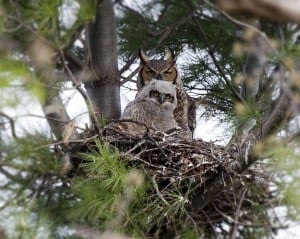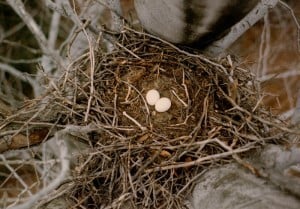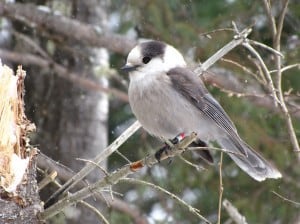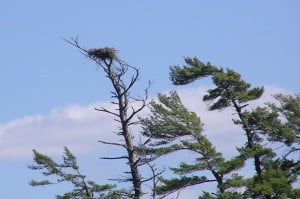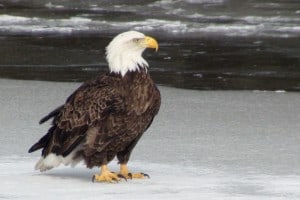Well, it is currently minus 23 with a minus 37 windchill outside, as I write this.
Nesting season may be the farthest thing from your mind. Afterall, we still have about 50 cms of snow in the bush, daylight is still at only about eleven hours in length, and did I mention how cold it is outside right now – February 24th? But, one species at least, has begun nesting already!
As we huddle in our houses stuffing more wood into the stove, (or going broke because of heating with petroleum products or electricity), the Great Horned Owls inhabiting the rural landscape are in fact quite involved with the duties of early nesting. In this part of their range, most females lay their eggs about the 20th of February, (give or take a week or so for some), and so, making them the earliest bird to begin nesting here.
More often than not, the owls move into the large, vacant stick nests originally built by Red-tailed Hawks – birds that share pretty much the same habitats as the owls, though the hawks are active in daylight, and the owls, from dusk until dawn. As is the case with all of nature, we can really only understand so much, as to why these seemingly bizarre events take place. When so much nesting activity takes place within the season we know as “spring”, why would these owls take to breeding in the harshest season of the year – winter?
Although there are no doubt less likely, yet still quite logical reasons we can come up with, the factor I believe that has the most to do with this early nesting, is simply one of timing: the timing of when the most readily available prey foods are in the greatest abundance. Among the owls, Great Horned Owls have one of the most varied diets of all. If we consider that if the owl lays her two eggs between the 20th and 25th of February, and that the normal incubation is 34 or 35 days, then the nest would finally contain young sometime during the last week of March.
At that time of year, the countryside is alive with many species that would appeal to the owls as potential meals, and during that hour or so of low light between sunset and nightfall, many are still quite active. Woodcocks, robins, killdeer, meadowlarks in and around fields and their edges, and noisy waterfowl in marsh and along shoreline. These are all within the typical avian fare of nesting Great Horned Owls, and in late March through April, they are commonly used for food, as revealed by decades of studying the prey remains I’ve found in and around the owls’ nests when they contain young.
After several months of prey being somewhat limited to voles, moles, shrews, mice, rabbits, squirrels, (and with some birds on the menu), the early spring offers a much wider variety of species to these owls, and in great abundance, too! By the time the young owls are entering into the early stages of their own independance in the summer, there is another boom in the “owl food industry”, in the form of the offspring of prey animals. The young prey too, being inexperienced themselves, are, in nature’s very balanced way, even more vulnerable to the young owls as they learn to secure their own meals.
And so, the timing, I believe, is the best I can accept as a reason for which such a bird would tolerate all of the brutal reality that winter would inflict upon it, to be such an early breeder. If they were to start a month later, things would be very different, I am sure. “Balance” will always be the answer. As humans, I suppose we like to pick up all of the pieces along the way, that will lead us to that same answer. If little else, it gives our minds something to do while we enjoy the feeling of awe that nature offers.
There are a few other “early birds” that are showing signs right now, of committed breeding behaviour. For example, even though they stay paired year-round, Gray Jays are just now beginning to gather nesting material and are constructing nests in the conifers of their choosing. Eggs will be layed next month. Ravens and Bald Eagles are showing more signs of courtship now as well, and are among the next group of birds to have eggs in their nests. Crossbills as well, (although there appears to be none to speak of in this area currently), will nest at just about any time of the year, (including now), if/when their staple conifer seed food crops are heavy enough to support them and their families. I guess you could call the crossbills “occasional and conditional early birds”.
And so, next time you are halfway home from work on some cold February evening and the heater goes in your car, I hope it does not give you too much grief. But, while you are fussing all about your rotten luck, give a thought to the determined female Great Horned Owls who may be, at the same time, covered in 5 cm of snow, 20 m up in the bare forest canopy sitting on a pile of old twigs, trying to keep their eggs from freezing, while they wait for their mates to show up with a warm meal. I’m certain that the thought of that, will make you feel a little bit warmer. I had no heater in my vehicle for two winters, and I had thought of those owls while I drove along freezing on a few occasions, and it did make me feel a little warmer – I kid you not!!
We’ll see “What Birds Are Nesting Now” in about a month from now – stay tuned
Tim Dyson
Cordova Mines
